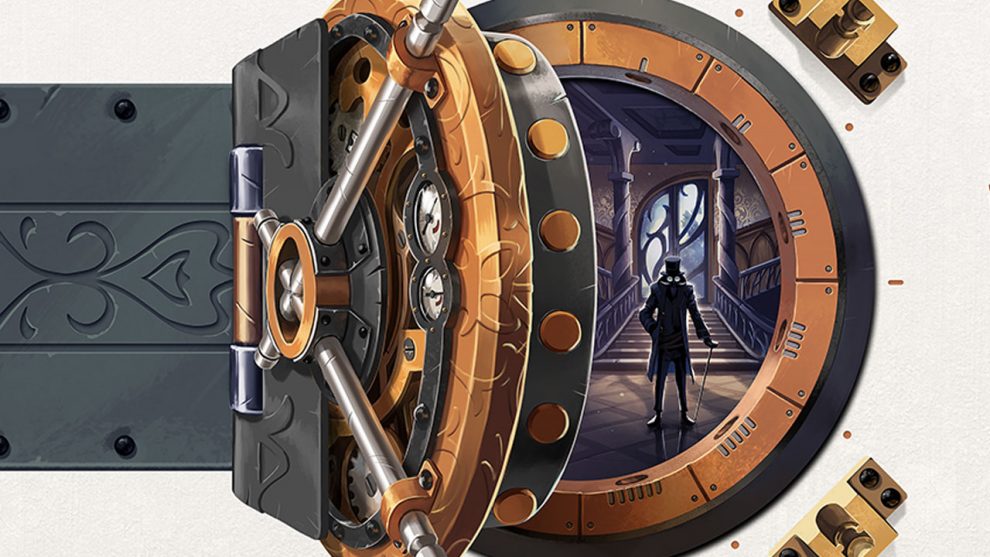Double-Time Heist
When the world’s most valuable artifacts start disappearing throughout time, four adventurers are called upon to find them and restore them to their rightful eras. Professor Evil is no slouch at time-thievery; I mean he’s stolen everything from Excalibur, to DaVinci’s notebook, to the Crystal Skull (don’t worry, no Shia LaBeouf present). So how must these adventurers recover these incredibly rare artifacts? Easy. They simply need to break into Professor Evil’s impregnable Citadel of Time and steal them back! But it will take cooperation and ingenuity to outwit the master thief, because Professor Evil protects his Citadel with more traps than Jigsaw, and is on the prowl himself.
Professor Evil and the Citadel of Time by Fun Forge is a cooperative game for 2-4 brave steampunkish adventurers.
It’s Party Time
At first glance, the board looks like you’re playing “cool gamers Clue,” as it’s a square-roomed mansion with hallways and multiple entrances to each room, many of which have locked “doors” blocking entry. Some rooms will also contain treasures that are on a timer. The center of the board is a large clock that tracks how close Professor Evil is to nabbing that treasure and locking it away for good. Your goal is to steal 4 treasures from Professor Evil before he snatches them up.

Players will assume the role of one of the 5 included adventurers,each of whom have a character card with a special ability and a unique deck of cards. On a player’s turn, they will first draw two cards off their deck and collaborate with their teammates on which to keep. This card can be played at any point during the rest of the player’s turn. Then the player will take three basic actions in addition to playing the selected card. Players can choose to unlock a door (which makes movement easier for the team), move one space to a new room, disarm a trap, or rescue a treasure. Each treasure has prerequisite icons that correspond to traps in the mansion. To recover the treasure, you must turn off all of the indicated traps throughout the entire mansion.

To add another layer of challenge, each player must activate Professor Evil at the end of his or her turn. This involves rolling dice which will have a few different effects, including moving the Professor, advancing the time, or rewinding the treasure marker time which shortens the amount of time available to recover treasures. As the Professor roams around the board he will completely lock every room he moves through and reactivate all traps he passes. This can throw major wrenches into the player’s game plans. In addition, every time you successfully recover a treasure, all traps indicated on that treasure are reactivated, which makes the next treasure a bit harder to grab. The moment a player grabs a 4th treasure before the Professor does, the team wins!

The Land of the Lost Artifacts
The first time I saw Professor Evil and the Citadel of Time was at Origins 2017, and the art alone was drawing crowds. The illustrations are fantastic from top to bottom. The mansion is the first thing you see, and it is a simultaneously dark and colorful design that sets the heist mood well. The clock-centerpiece immediately sets off that this game is about “TIME.” Thematically, you are nabbing treasures stolen from time, but you are also managing your game time to recover them, and the Professor is advancing time to forever keep the treasures for himself. The character art is detailed and engaging and the adventurers all have an anachronistic steampunk look. The game wisely uses tarot-sized cards, which allows for larger print on the character cards, and greater visibility for the artwork.

In other areas, visibility is a small issue. The character standees look great, but they could certainly have been bigger. And while the mansion is a beautiful and highly detailed board, the traps and treasures can get lost in the rooms. In order to find the spot to retrieve and/or place treasures you must do a little… hunting (pun!). The game does include a “pin drop” locator on the room cards to help you figure out where to place treasures. This helps mitigate the time-sink in searching the board. Finally, the doors are simply black wooden bits (think Settlers of Catan roads), and it might have been nice to have locked-door standees to give them greater visibility on the thematically dimly-lit board.

Let’s Do the Time Warp Again
Professor Evil and the Citadel of Time is a mechanically smooth game. This game is all about managing time, so you fortunately won’t lose a lot of it teaching or setting up. The game mechanics click along like the gears of the central clock. After my first play at Origins I had some concerns about replayability. Would the game invite me to travel back to the future… I mean Citadel… and re-steal the treasures again? Now that I’ve played a few times, I can say that the game does offer unique challenges every time you play. The Professor’s movements and actions are tied to the dice, and what he does directly impacts your decisions as a team. Some games you feel like you’re coasting smoothly and the Professor comes back with a vengeance. Some games you lose a couple treasures but your team narrowly escapes the Citadel with a win. And much of the time you are keeping neck-and-neck with the Professor, having to make crucial decisions about pressing your luck to gain a treasure, or letting it go to rescue a different one later in time.

The adventurers themselves also add to the replayability. Aside from there being 5 to choose from, each adventurer is truly unique. They each have unique strengths that are represented on their character card and within their character deck. One character might be a bit faster and have abilities that allow him to jump around the board, while another is good at disarming traps and using them to his advantage, and yet another can manipulate the clock and take extra actions. The combinations of cards you draw each turn and each round will change how you play each turn, and you’ll often be drawing different pairs of cards to choose from.
The Final Countdown
This is a very accessible gateway cooperative game, and that is a crowded field these days. I’m still experiencing some burn-out from a certain well-known disease-ridden cooperative game. I was looking for a new one that would be easy to teach to newer gamers and offer a fun, short play experience while still offering a challenge. Professor Evil and the Citadel of Time meets all those needs, and it accomplishes a couple things that set it apart from similarly-weighted cooperative games.
First, the art and theme really is a draw. There’s just something that’s appealing to me taking on the role of a steampunk adventurer and committing a treasure-rescuing heist. It’s fun to work together to sneak your characters around an ominous mansion, unlocking doors, and disarming traps. When I stand the theme, art, setting, and design of Professor Evil and the Citadel of Time against similar games, I’m simply drawn to it a bit more.
And second, the character decks are a unique feature I haven’t seen in too many light cooperative game, and it really has a big impact. Many games offer the opportunity to take the role of a character with a unique ability. Professor Evil ups the ante by not only giving each adventurer a unique ability, but giving them an additional deck of 8 cards, each of which has a unique ability as well.

While Professor Evil is moderately light, the cards add some surprisingly deep combinations to the game. Several times I found the card abilities allowed for some inventive plays by members of my group that elicited that “high-five!” response when they rescued a treasure in the nick-of-time. These cards are a simple addition, yet add a surprising amount of depth to the game. I hope future expansions will add more cards to the character decks, giving them even more variety and creativity.
Professor Evil and the Citadel of Time manages to be both accessible enough that new gamers can easily sneak in, yet deep enough that seasoned gamers will enjoy stealing some time away to play. It’s currently my go-to light cooperative game, and I’m looking forward to raiding the Citadel once again in the future (or present… or past).












If there are 5 characters to choose from, why is it only a 4 player game? Could we go ahead and allow a 5th player?